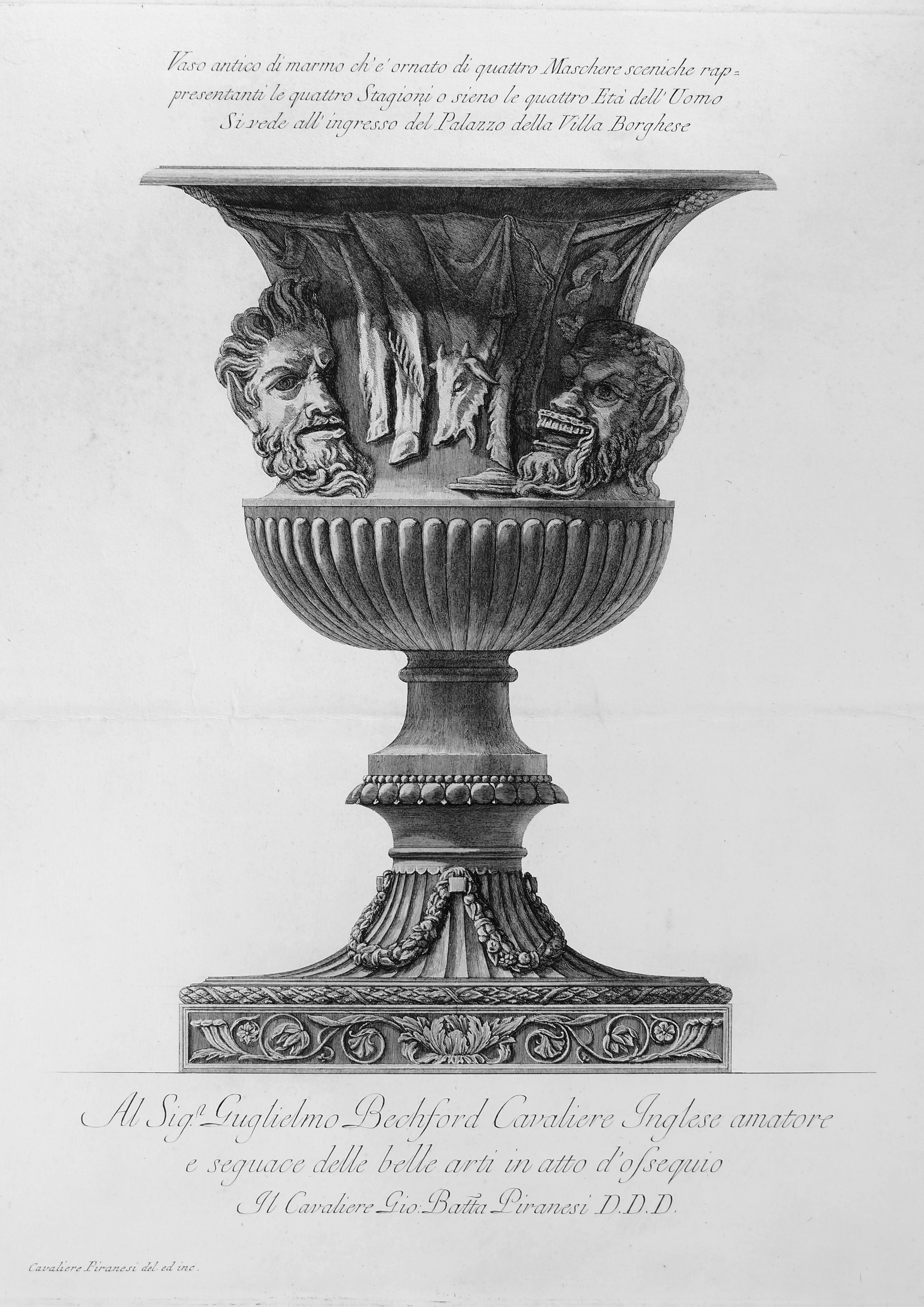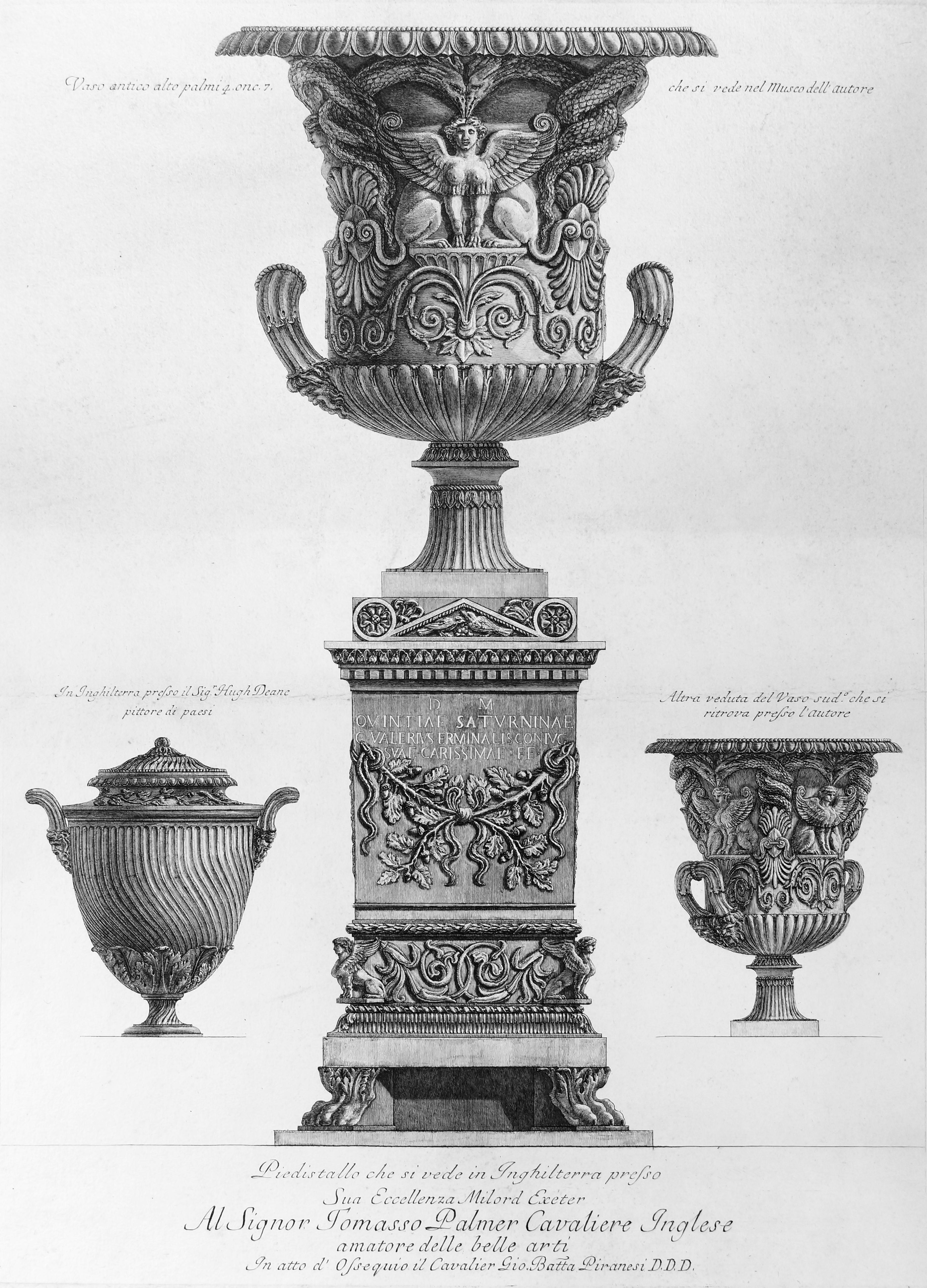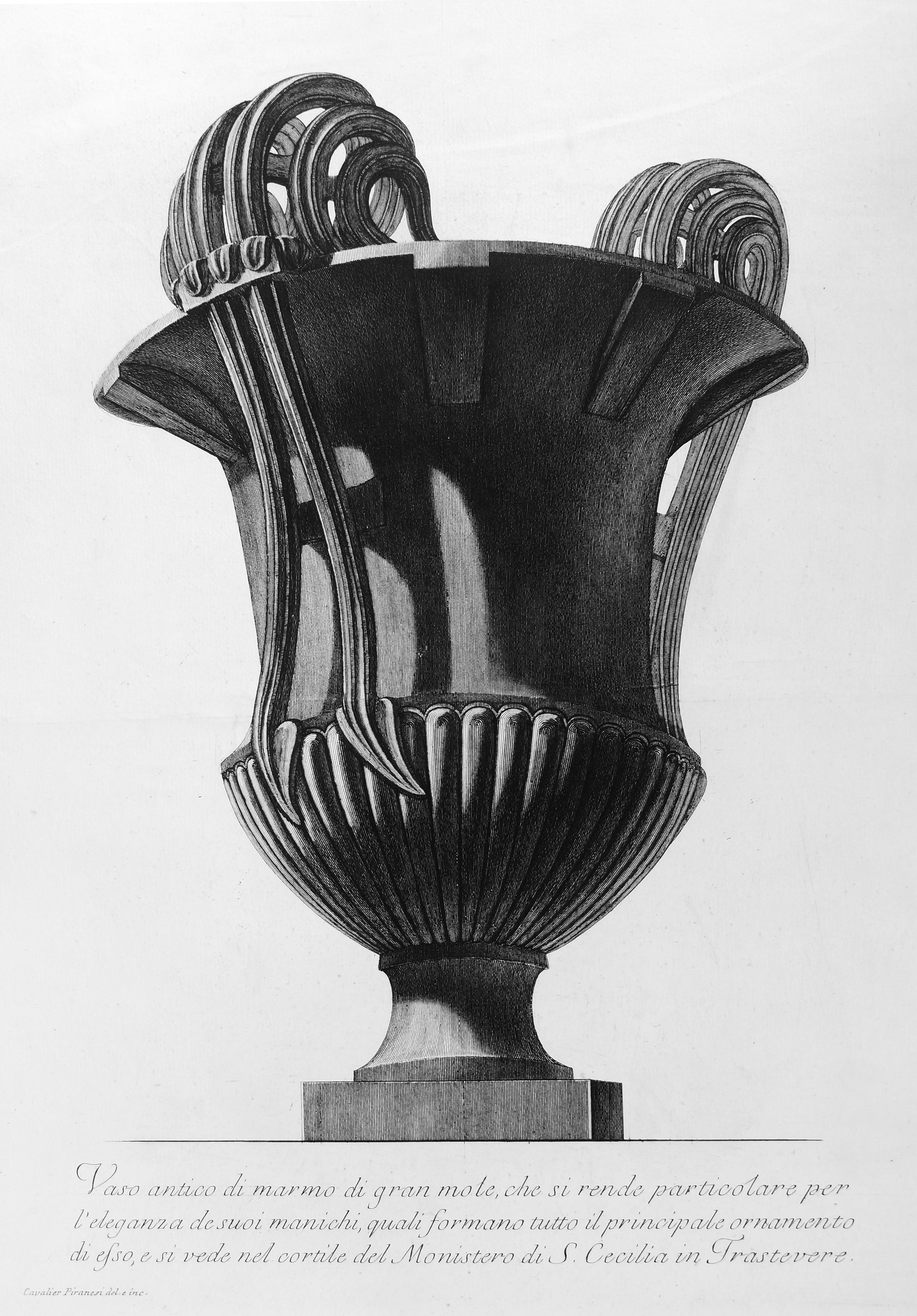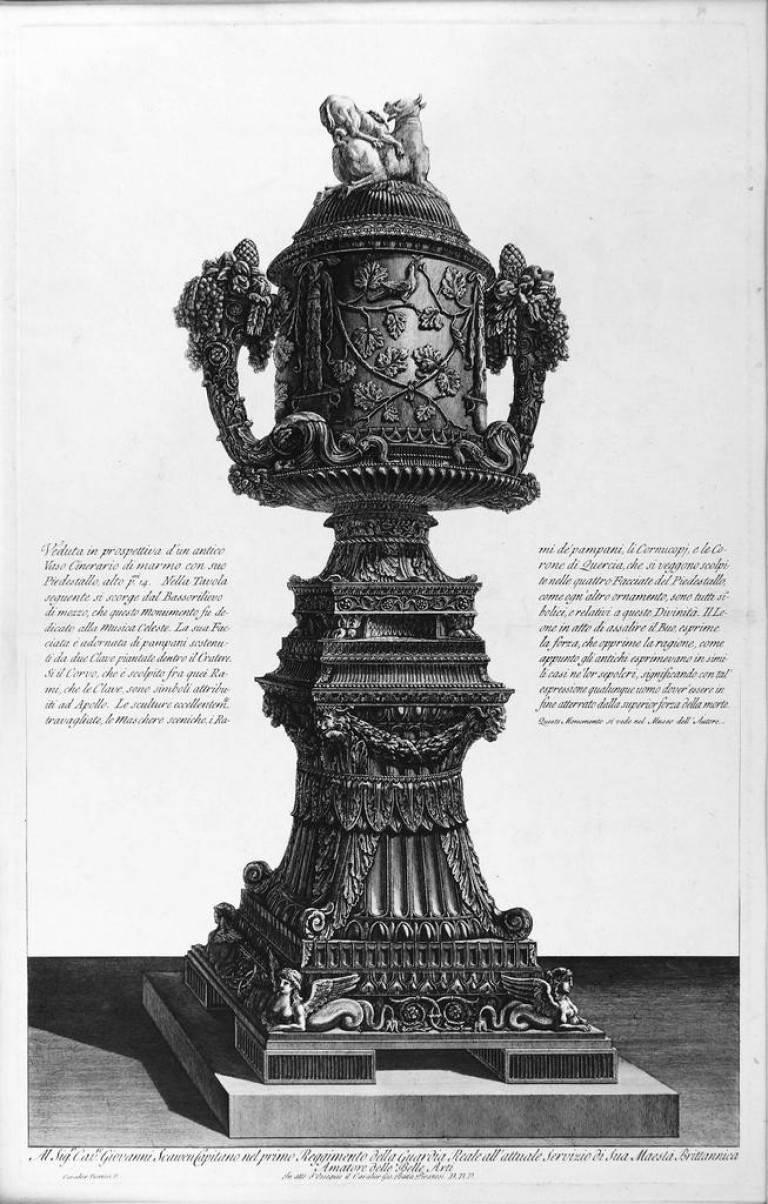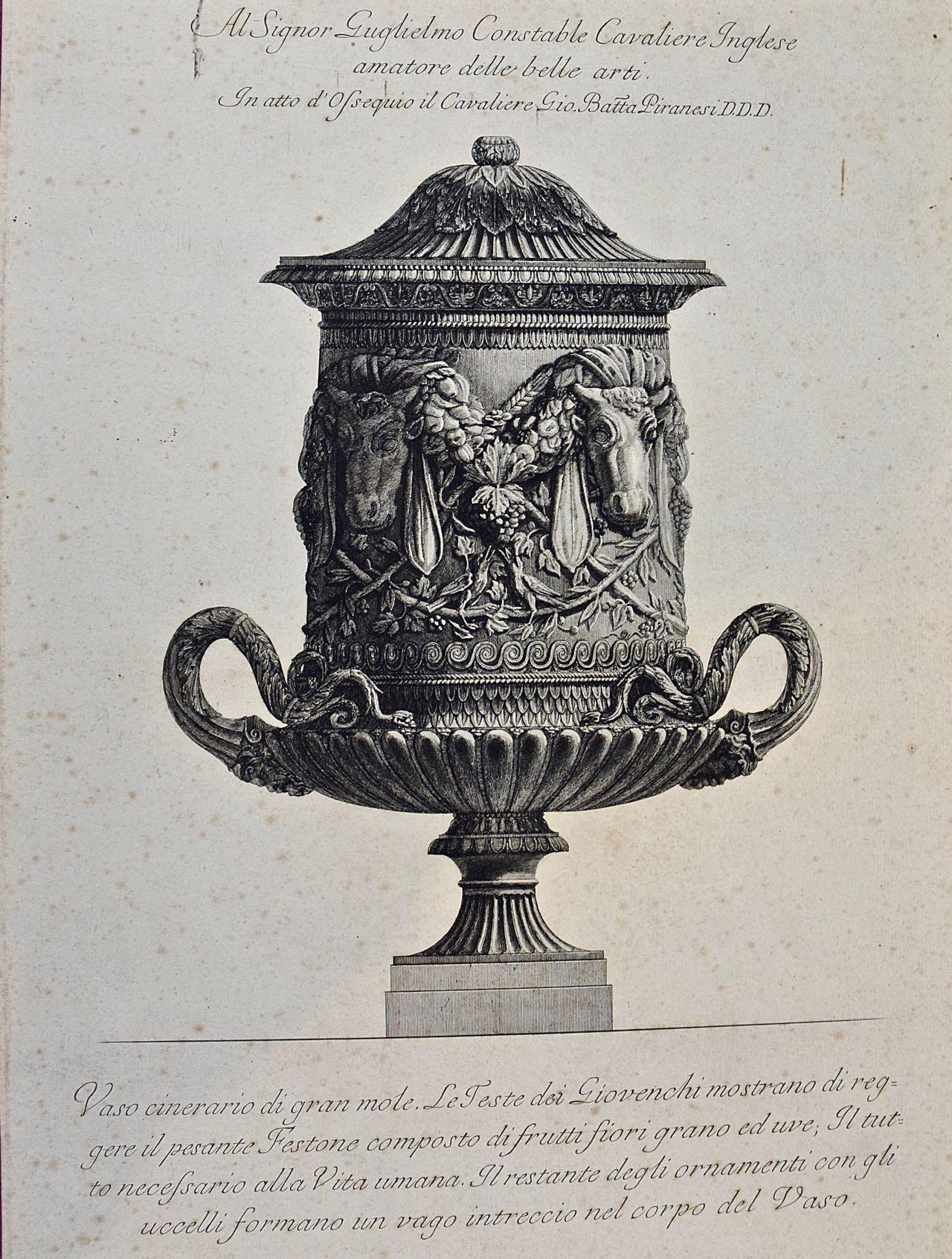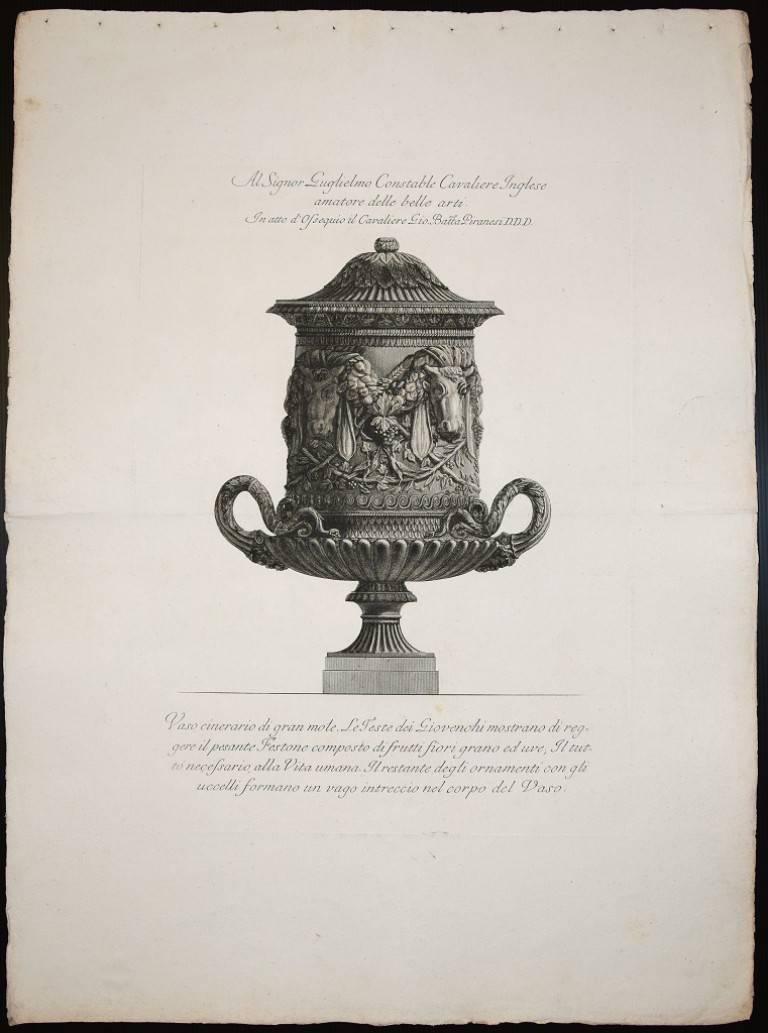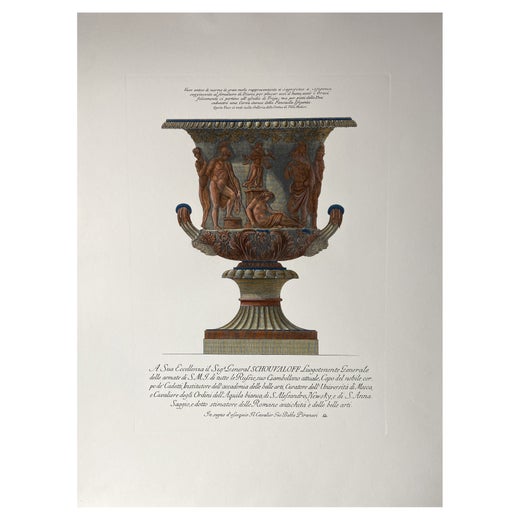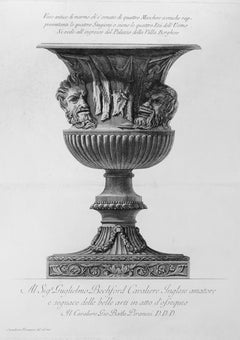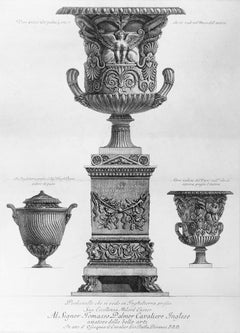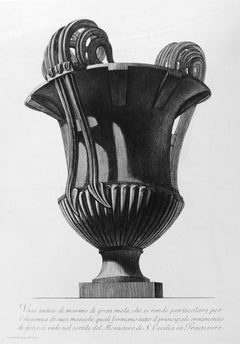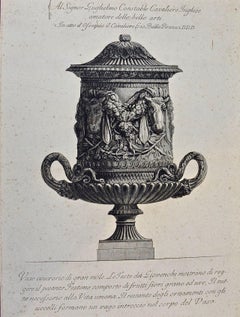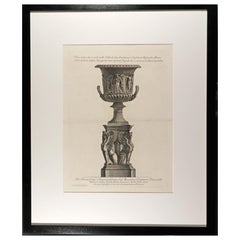Items Similar to Vaso antico che si vede nella Villa di Sua Eminenza Card. Alessandro Albani
Want more images or videos?
Request additional images or videos from the seller
1 of 5
Giovanni Battista PiranesiVaso antico che si vede nella Villa di Sua Eminenza Card. Alessandro Albani1778
1778
$1,564.35
£1,158.17
€1,300
CA$2,165.95
A$2,364.70
CHF 1,239.72
MX$28,720.22
NOK 15,482.04
SEK 14,619.18
DKK 9,897.18
About the Item
Artist's proof, printed on antique watermarked paper, wide margins, representing an “antique vase in the Villa Albani” as pointed out in the higher note. Etching with good contrasts and sharp details, dedicated to “Reverendissimo Monsignor Gianmaria Riminaldi, uditore della Sacra Rota”. Signed on plate “Cavaliere Piranesi del. ed. inc.” on lower left corner. Good conditions, lightly worned paper, the paper is fold on center, a light ripple on high-right margin, some tiny marks, little holes on the higher margin due to the binding of the volume “vases and Candelabras”.
Image Dimensions : 38 x 53.8 cm
Undoubtedly Piranesi was one of the most important engravers in 18th century even if he was well-known as an architect and an archaeologist: the greatest engraver in the period from Rembrandt a Goya. The generations after him have continued to imagine the Ancient Rome as the artist has portrayed his magnificent in "Vedute".
References:
L. FICACCI, Piranesi, The Complete Etchings, Taschen, p. 606, fig. 766;
A.A.V.V., Giovanni Battista Piranesi, Architetture, fantasie e grotteschi, Antichità Romane, Catalogo 24, Antiquarius, Roma, 2004, p. 72
- Creator:Giovanni Battista Piranesi (1720-1778, Italian)
- Creation Year:1778
- Dimensions:Height: 31.5 in (80 cm)Width: 22.84 in (58 cm)Depth: 0.04 in (1 mm)
- Medium:
- Movement & Style:
- Period:1770-1779
- Condition:Insurance may be requested by customers as additional service, contact us for more information.
- Gallery Location:Roma, IT
- Reference Number:Seller: J-621131stDibs: LU65032650481
Giovanni Battista Piranesi
Piranesi was born in Venice in 1720 and died in Rome in 1778. He was the son of a stone mason and was trained as an architect. After a slow start he eventually achieved great success as an architect, archaeologist, artist, designer, collector, and antiquities dealer. His mission was to glorify the architecture of ancient Rome through his engravings and etchings. His highly dramatized prints often depict imaginary interiors and frequently include figures in mysterious activities, who are dwarfed by the magnitude of their monumental surroundings. Piranesi's style greatly influenced the neoclassical art movement of the late 18th century. His dramatic scenes inspired generations of set designers, as well as artists, architects and writers. His prints have continued to increase in value to institutions and collectors.
About the Seller
4.9
Platinum Seller
Premium sellers with a 4.7+ rating and 24-hour response times
1stDibs seller since 2017
7,709 sales on 1stDibs
Typical response time: 2 hours
- ShippingRetrieving quote...Shipping from: Roma, Italy
- Return Policy
Authenticity Guarantee
In the unlikely event there’s an issue with an item’s authenticity, contact us within 1 year for a full refund. DetailsMoney-Back Guarantee
If your item is not as described, is damaged in transit, or does not arrive, contact us within 7 days for a full refund. Details24-Hour Cancellation
You have a 24-hour grace period in which to reconsider your purchase, with no questions asked.Vetted Professional Sellers
Our world-class sellers must adhere to strict standards for service and quality, maintaining the integrity of our listings.Price-Match Guarantee
If you find that a seller listed the same item for a lower price elsewhere, we’ll match it.Trusted Global Delivery
Our best-in-class carrier network provides specialized shipping options worldwide, including custom delivery.More From This Seller
View AllVaso antico di marmo che è ornato di quattro Maschere - Etching 1778
By Giovanni Battista Piranesi
Located in Roma, IT
Antique marble vase decorated with four masks
Artist proof, printed on contemporary laid paper, wide margins, representing an “antique marble vase ...
Category
Late 18th Century Figurative Prints
Materials
Etching
Vasi Antichi - Etching by G.B. Piranesi - 1778
By Giovanni Battista Piranesi
Located in Roma, IT
Antique Vases
Artist proof, printed on contemporary laid paper, wide margins, representing two antique vases, whom details are in the captures. Etching with good contrasts and sharp ...
Category
Late 18th Century Figurative Prints
Materials
Etching
$1,534 Sale Price
25% Off
Vaso Antico di marmo di gran mole... - Etching - 1778
By Giovanni Battista Piranesi
Located in Roma, IT
Large antique marble vase in S. Cecilia in Trastevere
Artist proof, printed on contemporary laid paper, wide margins, representing an antique marbl...
Category
Late 18th Century Figurative Prints
Materials
Etching
$1,263 Sale Price
25% Off
Veduta in Prospettiva d'un Antico Vaso Cinerario di Marmo
By Giovanni Battista Piranesi
Located in Roma, IT
The same urn, in perspective
Beautiful artist proof, printed on antique laid paper, large margins, showing a precious urn. Etching with good contrasts and sharp details, signed on pl...
Category
1770s Old Masters Figurative Prints
Materials
Etching
Vaso Cinerario di Gran Mole
By Giovanni Battista Piranesi
Located in Roma, IT
Artist's proof, printed on antique laid paper, large margins, representing an antique marble vase, whose details are described in the ending note....
Category
1770s Old Masters Figurative Prints
Materials
Etching
Vaso antico di marmo, che si conosceva nella Galleria del Palazzo
By Giovanni Battista Piranesi
Located in Roma, IT
Artist's proof, printed on antique laid paper, large margins, representing an “antique marble vase in the gallery of the palazzo Barberini” as he r...
Category
1770s Old Masters Figurative Prints
Materials
Etching
You May Also Like
Ancient Roman Marble Vase: 18th C. Piranesi Etching Vaso Cinerario di Gran Mole
By Giovanni Battista Piranesi
Located in Alamo, CA
"Vaso Cinerario di Gran Mole. Le Teste dei Giovenchi mostrano di reggere it pesante Festone composto di Frutti Fiori Grans ed use. Il tuto Necefsario all Vita Umana. Il Restante degl...
Category
1760s Old Masters Figurative Prints
Materials
Etching
Giovanni Battista Piranesi (Italian, 1720–1778), Engraving of an Urn
By Giovanni Battista Piranesi
Located in Downingtown, PA
Giovanni Battista Piranesi (Italian, 1720–1778)
Engraving of an Urn
Rome, circa 1768–1778
Etching on paper
Dimensions: 35 × 29 1/8 × 1 1/2 in.
Executed and published in Rome during...
Category
Antique Late 18th Century Italian Georgian Prints
Materials
Paper
Ancient Roman Medici Marble Vase: An 18th Century Etching by Piranesi
By Giovanni Battista Piranesi
Located in Alamo, CA
This large 18th century etching by Giovanni Battista Piranesi is entitled "Vaso antico di Marmo adornato di eccellenti Sculture si nella parte anteriere che nell' opposta, le quail r...
Category
1770s Old Masters Figurative Prints
Materials
Etching
Contemporary Italian Hand Coloured Vase Print in Villa Lante G.B Piranesi 2 of 2
By Giovanni Battista Piranesi
Located in Scandicci, Florence
Extra large Roman marble vase on a porphyry pedestal printed on a hand press on 100% cotton engraving paper.
Completely handpainted with a cream wash, umber highlights, and matte bla...
Category
21st Century and Contemporary Italian Neoclassical Prints
Materials
Wood, Paper
A Framed 18th C. Piranesi Etching of an Ancient Marble Vase from Hadrian's Villa
By Giovanni Battista Piranesi
Located in Alamo, CA
This large framed 18th century etching by Giovanni Battista Piranesi is entitled "Vaso antico di Marmo adornato di eccellenti Sculture si nella parte anteriere che nell' opposta, le ...
Category
1770s Old Masters Figurative Prints
Materials
Etching
(Large!) UNA DELLE QUATTRO FIGURE RAPPRESENTANTI QUATTRO VITTORIE
By Giovanni Battista Piranesi
Located in Santa Monica, CA
GIOVANNI BATTISTA PIRANESI (1710-1778)
UNA DELLE QUATTRO FIGURE RAPPRESENTANTI QUATTTRO VITTORIE, (Focillon 330, Wilton-Ely 463) 1750-1756
Etching, Plate 48 from “Le Antichita Romane“ vol. 3. Engraved by Jean Barbault...
Category
1750s Old Masters More Prints
Materials
Etching
More Ways To Browse
Vase And Candelabra
Rene Magritte Etching
Rene Quillivic
Renoir Maternite
Retour Magritte
Retro Spoleto Posters
Richard Lindner Collage
Robert Longo Cindy
Roy Lichtenstein Thinking Of Him
Ruth Waddy
Sadao Watanabe. On Sale
Salvador Dali Argillet
Salvador Dali Artist Proof
Salvador Dali Canto 7
Salvador Dali Don Quixote Etching
Salvador Dali Exhibition Poster
Salvador Dali Icarus
Salvador Dali Judgement
